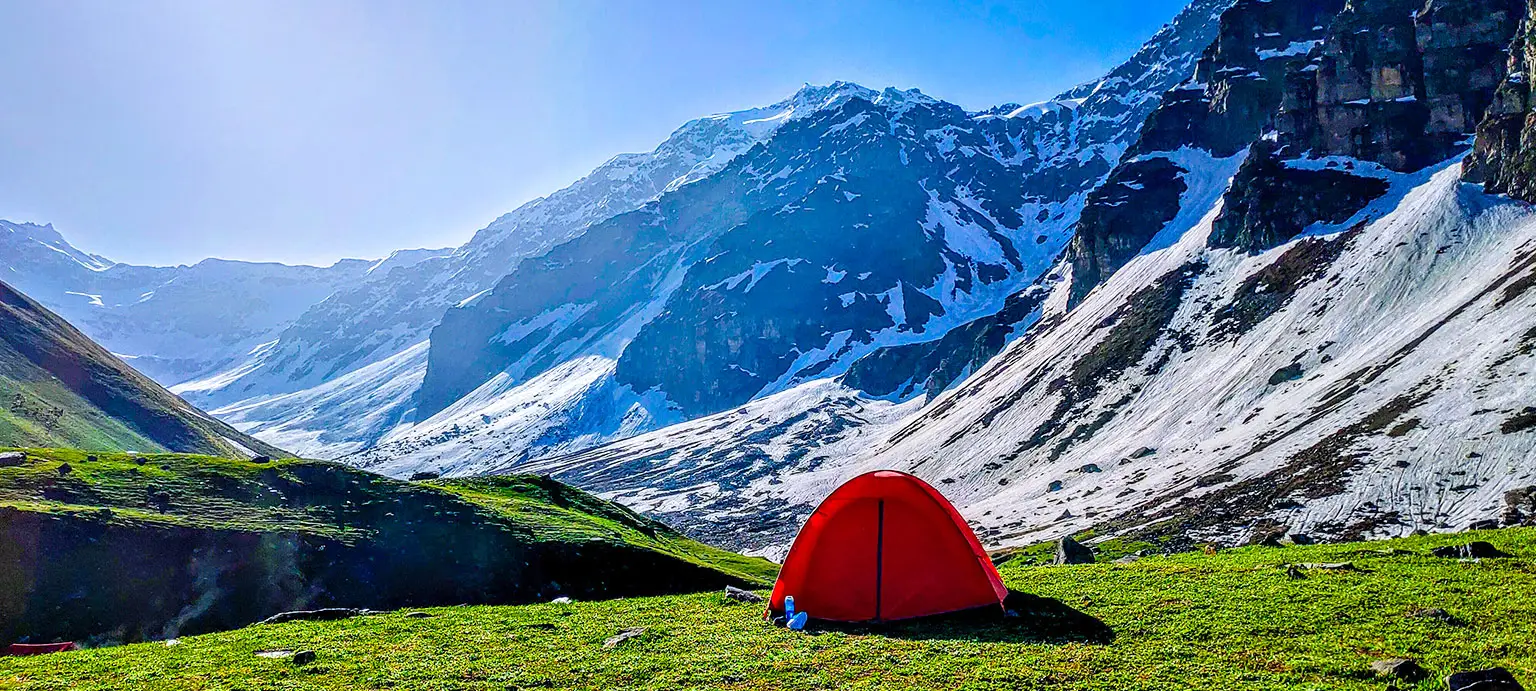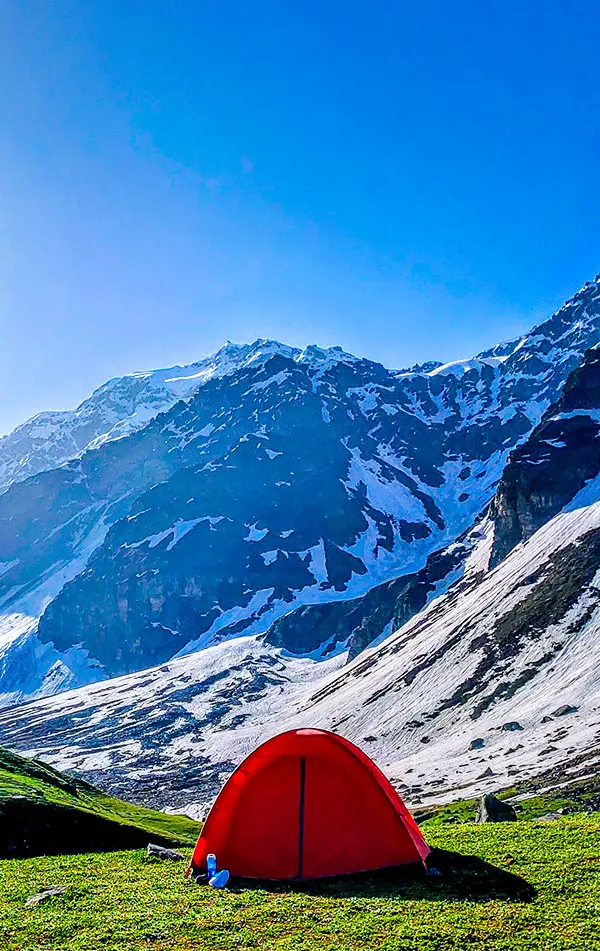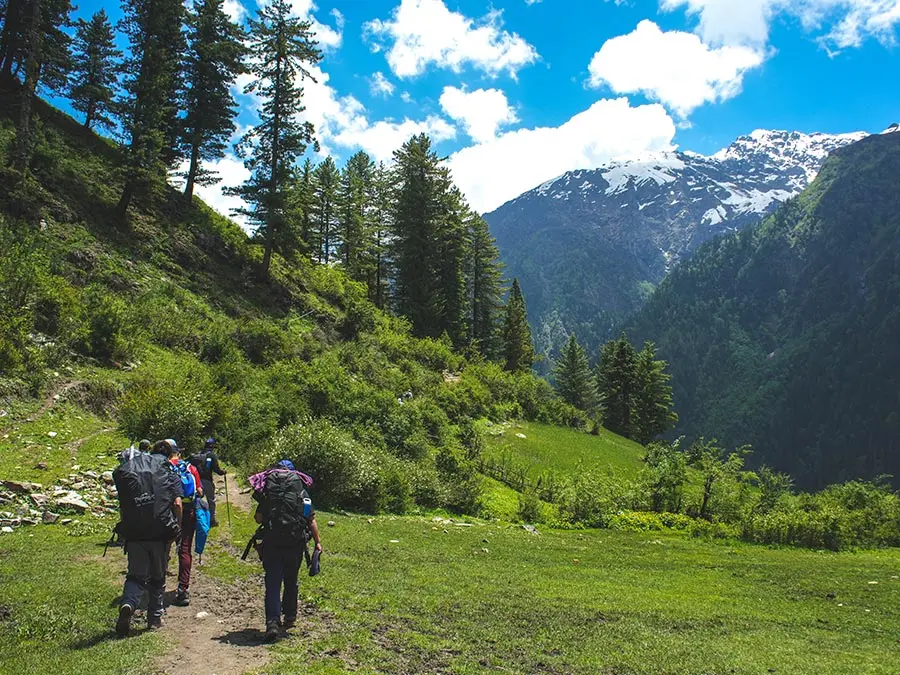
Region
Himachal Pradesh | India
Duration
7 Days
Max Altitude
15000 Ft.
Trekking Km
42 KM
Grade
Moderate to Difficult
Help & Support
+91 8191004846 info@trekthehimalayas.com10:00 hrs to 18:00 hrs | GMT +5:30
Monday - Saturday | Sunday Closed
15500 /Person
- May-2024
- June-2024
- +5% GST (goods and services tax)
- Services Janglik to Barua village
- Addons
-
Insurance is Mandatory.
-
Non-Indian rates are slightly higher. Trek coordinator will provide balance payment link post-booking.
- Get insurance through us or elsewhere. If not through us, email for a refund after booking.
-
The cancellation policy will be implemented in accordance with the trek cancellation policy.
-
Transportation Shimla to Janglik & Barua village to Shimla is optional
-
Choose add-ons during booking. If missed, log in and add them later
-
Book transportation at least 10 days before the trek.
-
The cancellation policy will be implemented in accordance with the trek cancellation policy.
-
Backpack offload is optional
-
Choose add-ons during booking. If missed, log in and add them later.
-
Book off-load at least 10 days before the trek.
-
For offline bookings at the base camp, a convenience fee of Rs. 2500 applies.
- Offload can't weigh more than 11kg, Offload should have a Waterproof cover. Suitcases /trolleys will not be allowed.
-
In the event that you choose to cancel your trek prior to the departure date, you will receive a full refund.
Insurance 245
Transport 2500
Offload 2200
For more information. Please complete this form.
Help & Support
+91 991 772 4737info@trekthehimalayas.com 10:00 hrs to 18:00 hrs | GMT +5:30
Monday - Saturday | Sunday Closed
Overview
Trek Name: Buran Ghati Pass Trek
Days: 7
Adventure Type: Trekking
Base Camp: Janglik
Season:Summer | Autumn |
Month:May | June | September | October |
Country: India
Altitude: 15000 Ft.
Grade: Moderate to Difficult
Rail Head: Kalka
Stay: Homestay & Camping
Food: Meals while on trek & at Homestay
Location: Himachal Pradesh
Distance: 42 Km.
Trail Type: Cross over trail | Start in one valley, traverse the pass, and ends in another valley.
AirPort: Jubbarhatti Airport, which is 22 km away from Shimla
Highlights:
- +5% GST (goods and services tax)
- Services Janglik to Barua village
Why Buran Ghati Is A Must-Do Trek ?
- Buran Ghati Trek combines the best elements of various Himalayan trails, offering unparalleled scenic beauty throughout the journey.
- The trek takes you through forests of birch, maple, pine, and oak trees, providing a rich sensory experience.
- The trek includes technical sections, such as crossing the challenging Barua Pass, which demands good maneuvering skills.
- Visit the sacred Chandranahan Lake, believed to be emanated by the Gods, offering stunning alpine scenery.
- Explore the beautiful Dayara Meadows, a scenic stretch with grazing horses and a backdrop of snow-covered mountains.
- Pass through ancient villages, Janglik and Barua, showcasing Himalayan culture and architecture.
- Encounter the challenging Buran Pass, which transforms into a wall of ice until June, providing a rappelling opportunity.
- Experience the breathtaking Litham campsite, nestled in the confluence of two valleys with stunning waterfalls.
- Enjoy panoramic views of the majestic Dhauladhar Range, one of the lower Himalayan mountain chains.
- Witness remote peaks popping above each other, creating a spectacular visual treat.
- Buran Ghati offers a comprehensive trekking adventure, encompassing cultural richness, thrilling challenges, and diverse landscapes.
.webp)
Who Can Participate
- Age; 12 years +.
- First timers can apply; previous trekking experience is more appreciated.
- The climber must be fit and have sufficient stamina to cover 5 km of distance in 35 minutes without stress.
- The climber should be able to carry a 10-15 kg backpack.
Itinerary
Shimla to Janglik
- Altitude:- 2,800m/9,200ft.
- Drive Distance: 160 km |9-11 hr.
- Pick-up:- Shimla Old Bus Stand at 6.30 am.
- Phone Network:- Rohru.
- Breakfast and lunch excluded, dinner included.
- Shimla - Rohru: 115 Km Rohru to Chirgaon: 15 km Chirgaon to Tangdu: 20 Tangdu to Janglik: 10km.
Janglik is our base camp for the Buran Ghati trek and it is at a distance of approximately 160 km from Shimla. From Shimla we will drive past Rohru in a scenic drive, Pabbar River flowing alongside the route. Driving past many quaint Himalayan hamlets, witnessing Himalayan culture and architecture, we will reach the pine covers in Tangdu and further past, we will arrive at Chirgaon. From here, it is mostly a dirt track but the journey is not very long.
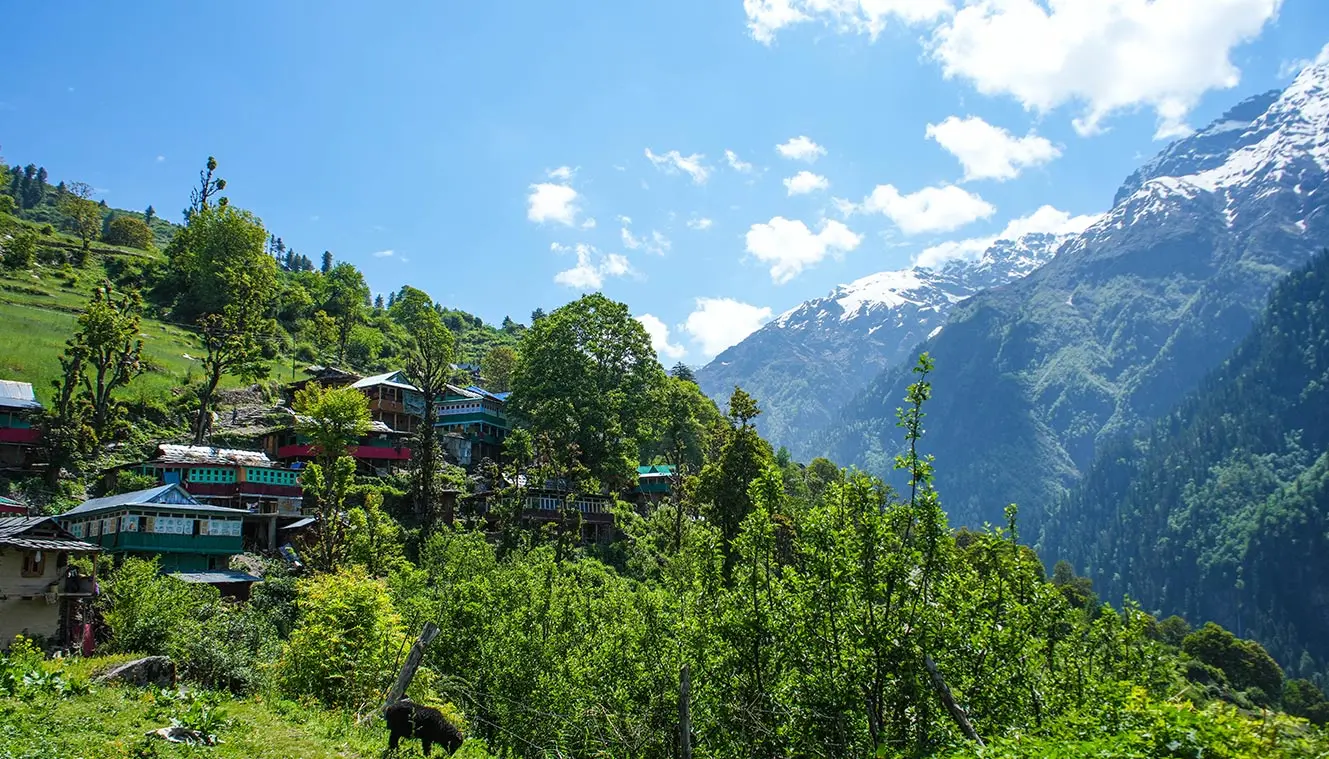
Transportation to Janglik will be arranged at the pick up point in Shimla and we will drive till the closest roadhead to Janglik. We will have our lunch at Chirgaon. Also, keep in mind that the last ATM point is at Rohru, so if you are to withdraw cash, you need to do it from here. Also, the mobile coverage is available till Rohru, after that there is no mobile network. After reaching Janglik, we will check-in a local guest house or sleep in the campsite. Hot Dinner will be provided at the campsite/guesthouse. In case of bad weather road conditions turn bad so we might take a short hike of approx. 1.5 Km to reach base camp Janglik from Tangdu
Janglik to Dayara Thatch
- Altitude:- 3,400m/11,150ft.
- Altitude Gain:- 600m/1,950ft.
- Trek Distance: 7 km to 8 km | 5-6 hr.
- Grade: Moderate ascent.
- Water sources available on the way.
- Lunch and snacks offered at campsite.
- You will cross few shepherds hut on the way.
- Trek though pine, Oak, deodar forest and meadows.
- In the evening climb some hillock for better acclimatization.
- Stay in tent (twin sharing)
Waking up to a beautiful valley view at Janglik, we will have a delicious breakfast with warm tea before we begin our journey ahead. Today is the most scenic day of the trek as you climb uphill, all the way to the Dayara Meadows. While it is a beautiful climb from Janglik to Dayara Thatch, with many picturesque vistas but you also gain altitude very rapidly.
We will ascend until we arrive at a forest cover of Oak and Pine. After walking for about 30 minutes through the forest cover, you will gradually begin to descend through the forest. As you come out of Janglik, you will see beautiful wheat fields lined by mud huts on the edges of the fields and soon we will leave these mud houses behind and begin climbing uphill.
After about an hour of trekking, you will step on to a ledge from where you can see spectacular views of Janglik, Tonglu and other surrounding villages. The ledge is beautifully set beneath pine cover. We will rest here for a while, admiring the view and enjoying some refreshments. From here, the trail goes through a clearing and again ascends up into a forest. The trail is steep at the beginning but soon turns into a gradual ascend. About 30 minutes later, you will get out of the tree line and step into a vast expanse in front of you. We will turn left and climb uphill slowly getting out of the tree line. The trail here is broad and well-defined.
After about an hour, we will enter another coniferous forest cover. The trail here ascends gradually and soon we will trail out of the forest again and into the lush green meadows of Dayara, surrounded by snow-clad mountains on all sides. Our campsite for the night. In the evening, we will climb small hillocks nearby for better acclimatization as there is a rapid altitude gain. After we come back from acclimatization walks, a hot dinner will be served at the campsite, after which we will retire in our camps.
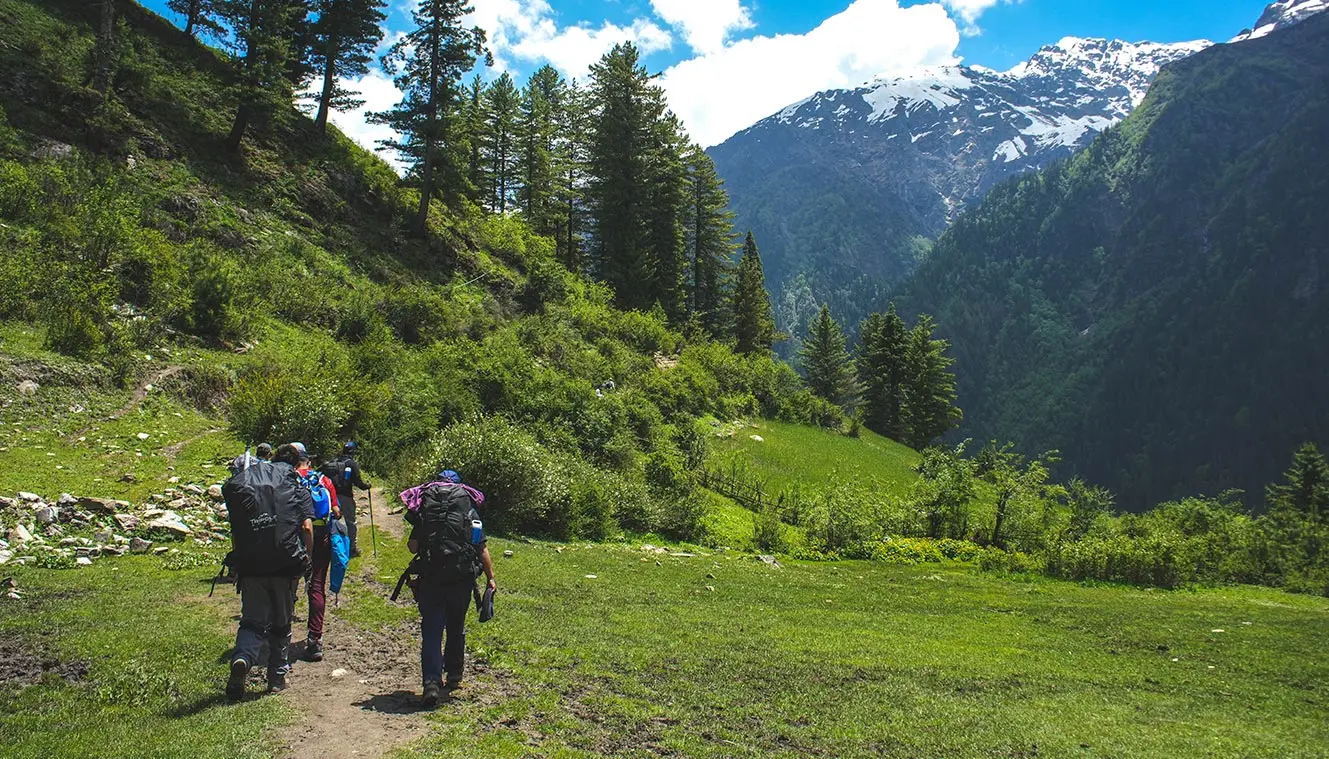
Dayara Thatch to Litham
- Altitude:- 3,600m/11,800ft.
- Altitude Gain:- 200m/ 650ft.
- Trek Distance: 5 km to 6 km
- Grade:- Easy gradual ascent and then descent.
- Major Attraction: Silver Birch trees and Chandrnahan waterfall, sights of Dhauladhar Range.
- Water sources available on the way.
- Hot lunch provided at campsite.
- Stay in tents (Twin sharing).
Starting the day early, exploring the Dayara Meadows after breakfast and the hot tea and begin our journey onward to Litham. In the morning rays of the sun, the meadows are simply captivating. You can soak in the morning freshness in the meadows and soothe your senses, leaving all worries behind. Photographers can capture some beautiful pictures of the morning rays of the sun in the vast meadows.
The trek from Dayara Thatch to Litham starts with a gentle ascent and the trail will take you through forest covers, meadows and streams. We will walk for about 15 minutes, gently ascending to a point where we will come across a stream. Ascending through forest covers of Oak and Pine, followed by a beautiful meadow we will begin descending through a silver birch forest cover and again through some lush meadows.
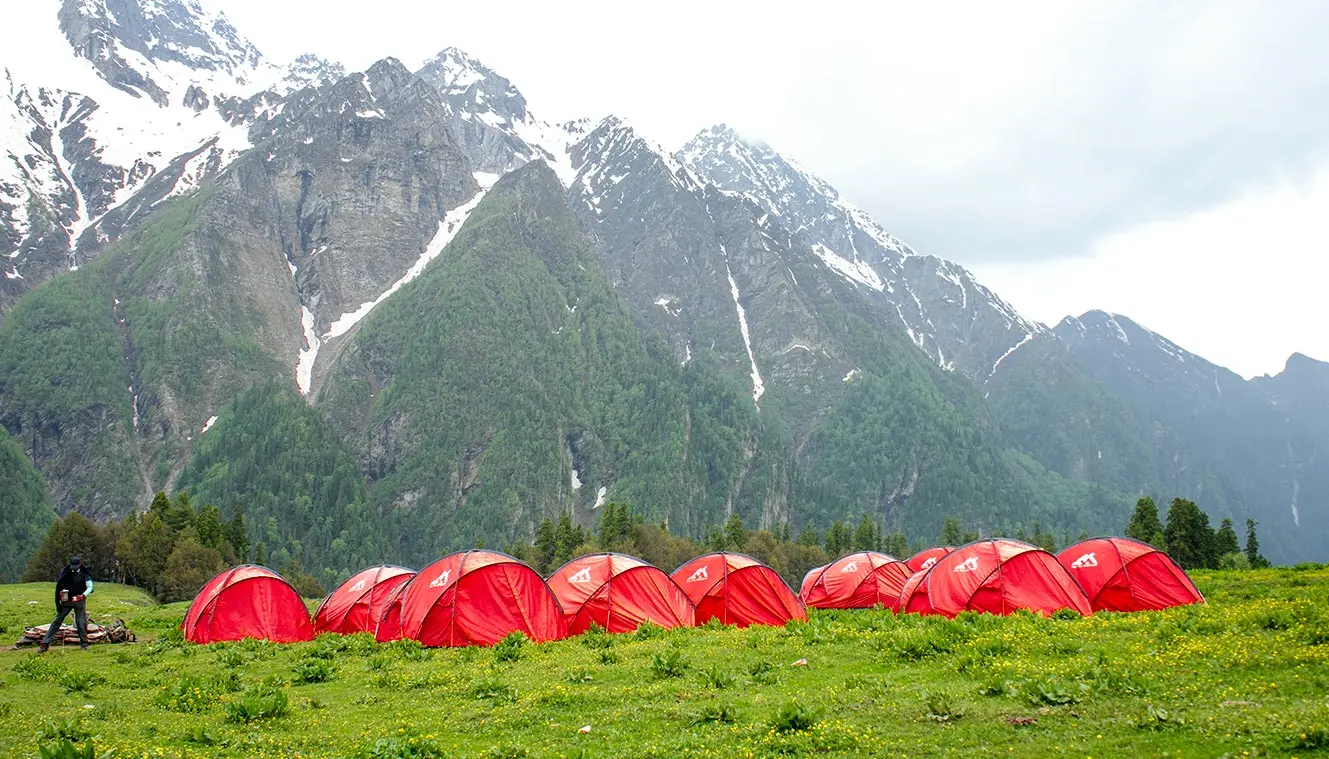
The entire trail is full of forest covers and meadows as well as some gushing streams, ample opportunities to refill your water bottles. Crossing the meadows we will trek towards the Guna Pass. A gentle ascent takes you to another forest cover and completely out of the Dayara campsite. We will cross a stream post which the trail climbs out of the thickets, with the Dhauladhar Range and Guna Pass coming into view.
Soon, we will come inside another forest of the Silver Birch trees. The silver birches are very old and you can see these ancient structures gnarled and majestic standing the test of time. Descending from the forest, you will come across another stream and the first clear views of Litham.
From the meadows, the trail begins to descend down to the Chandranahan stream, crossing the stream, we will arrive at our Litham campsite. From here you can observe the beautiful Chandranhan waterfall flowing from the Chandranahn snout, beyond this lies the Chandranahan Lake. We will stay the night at Litham campsite.
Acclimatization day, visit to Chandranahan Lake
- Altitude:- 4,023 m/13,200ft.
- Trek Distance: 4 km each side | 6-7 hr.
- Grade:- Difficult, Steep ascent and descent.
- Star early in the morning.
- Chandranahan is a group of 7 lakes and we will see 3 of them.
- Water sources available on the way.
- Hot lunch provided at campsite.
Today’s day is for acclimatization as we make our way to Chandranahan Lake and back to the Litham campsite. After having tea and breakfast, we will head out towards the Chandranahan Lake. It is a 6 km trek from Litham to Chandranahan Lake and back and you will get a lot of opportunities to click some stunning pictures.
The glacial lake of Chandranahan is fed by the mountains surrounding it. To reach the lake, we will cross the stream just before the Litham campsite and continue walking in an upstream direction until we reach the top of the ridge. From here, walk towards the snout of the waterfall. This is where the lake emerges. The walk to the snout takes about an hour and a half and the lake site is marked by stone cairns.
Many small waterfalls cascade down to the lake from all sides. You can spend some time here, absorbing the serenity and clicking some beautiful pictures. We will then head back to Litham in the same way that we came. We will have lunch at Litham and spend the rest of the day here and stay the night at camps.
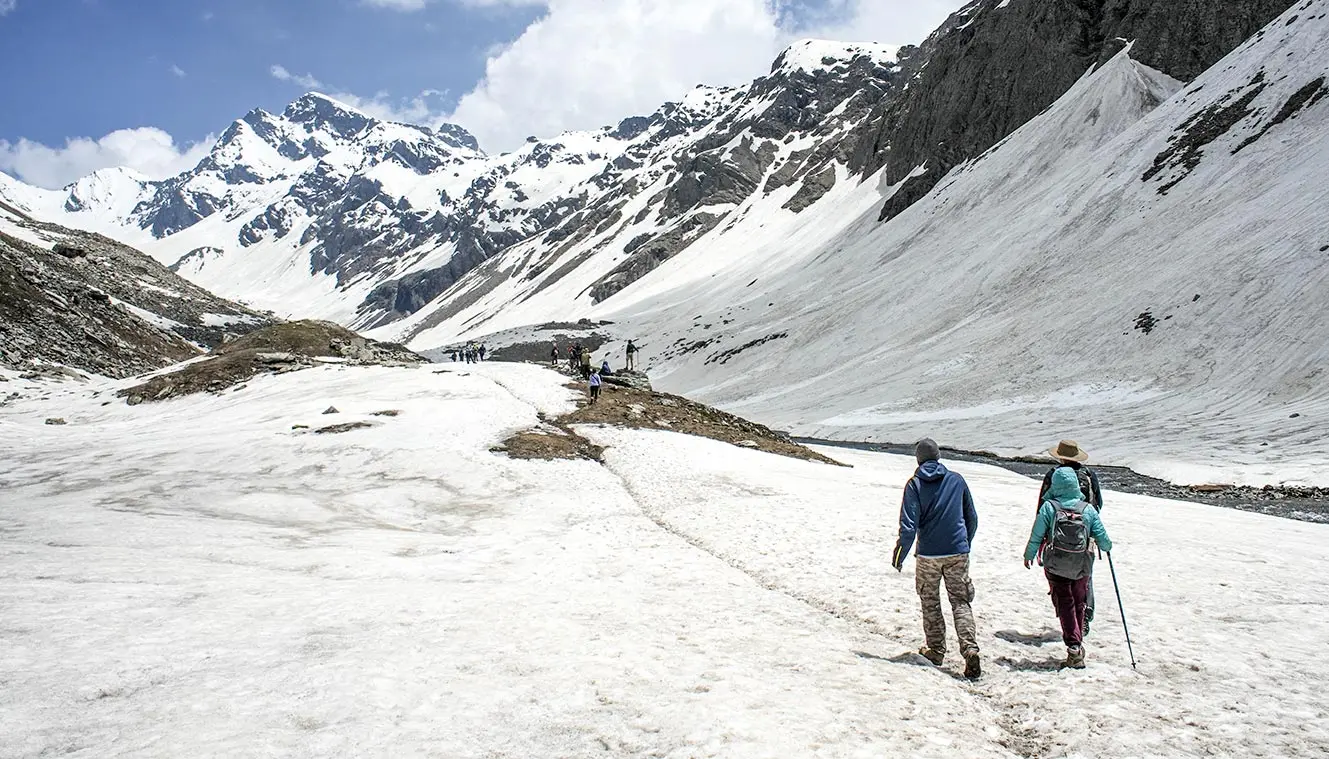
You will also get good amount of snow in the month of June. As you reach the lake you will notice that the lake is a bit smaller in size and is fed by the snowfields around it. You can spend some time around the lake and click pictures of the panoramic view it has to offer before heading to Litham again. It will be a steep descent to Litham, therefore, youll be starting early in the morning so that you reach Litham by lunch.
Litham to Dhunda
- Altitude:- 4,000m/13,100ft.
- Altitude gain:- 400m/ 1300ft.
- Trek Distance: 4 km to 5 km | 3-4 hr.
- Grade: Moderate with a mix of gradual and steep ascents.
- Water sources along the way.
- Hot lunch provided at campsite.
- Pass is visible from the camp site.
- Trail is well marked by the shepherds.
- Stay in tents (Twin sharing).
To reach Dunda from Litham it's approx. 3 hrs climb and you will arrive at an elevation of 13000 ft. from here, you can witness the magnificent Dhauladhar Range. Dunda at 13000 ft offers the perfect setting for the summit to the Buran Ghati Pass. From here its only a two hour climb to the Pass.
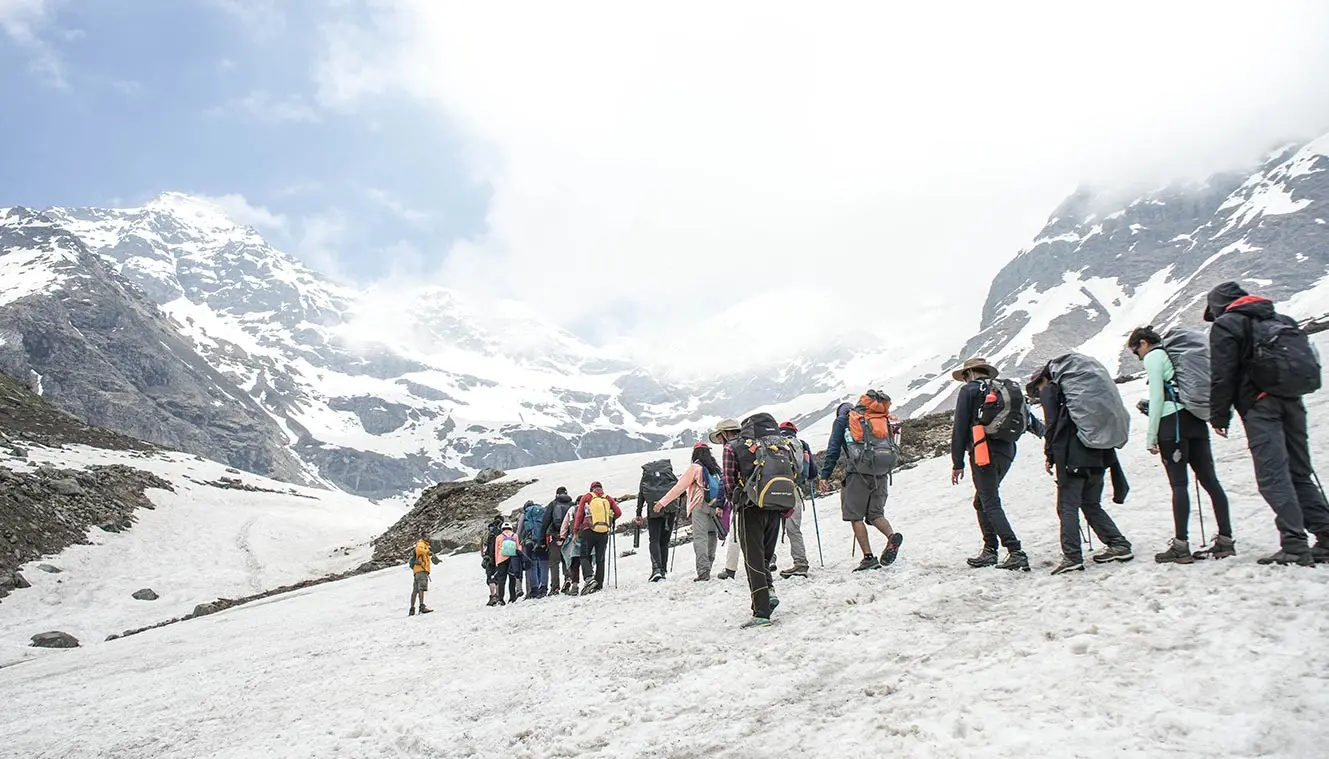
The trail takes a sharp acsent as you continue along the banks of the Pabbar River, which is now a gushing stream. Soon you will arrive at a U-shaped gorge and get your first views of the Buran Ghati Pass. Take a moment to relish sight before moving onward.
The climb to Dunda follows a well-defined trail and after about an hour’s climb you will arrive at the Dunda Ridge with spectacular views of Buran Ghati. The campsite is surrounded by snow-clad mountains on all sides. This is just the perfect alpine campsite with snowy mountains on all sides.
Dhunda to Munirang (River camp) via Buran Ghati Pass
- Munirang Campsite Altitude:- 3,400m/11,100ft.
- Buran Ghatti Pass:- 4,550m/15,000ft.
- Altitude loss:- 600m/ 2,000ft.
- Trek Distance: 8 km (10 - 11 hrs approx).
- Grade: Difficult with steep ascent and descent, (Always be with Trek leader and other support staff).
- Carry 2 litres of water from the campsite.
- Lunch provided on the way, evening snacks at the campsite.
- Another side valley is full of junipers and crested shrubs.
- Camp nearby the river and farmers hut.
- Stay in Camp by the River and farmer’s hut.
Today is the most strenuous trekking day and you will have to trek for about 10 to 11 hrs through both ascending and descending routes. From the Dunda campsite follow the ridge and you will have to cross some boulders as you move towards the base of the Pass. Once you reach the base, it will take an hour of uphill climbing to make it to the top of the Pass. The trail is mostly covered in snow and the top touches an altitude of 15000 ft.
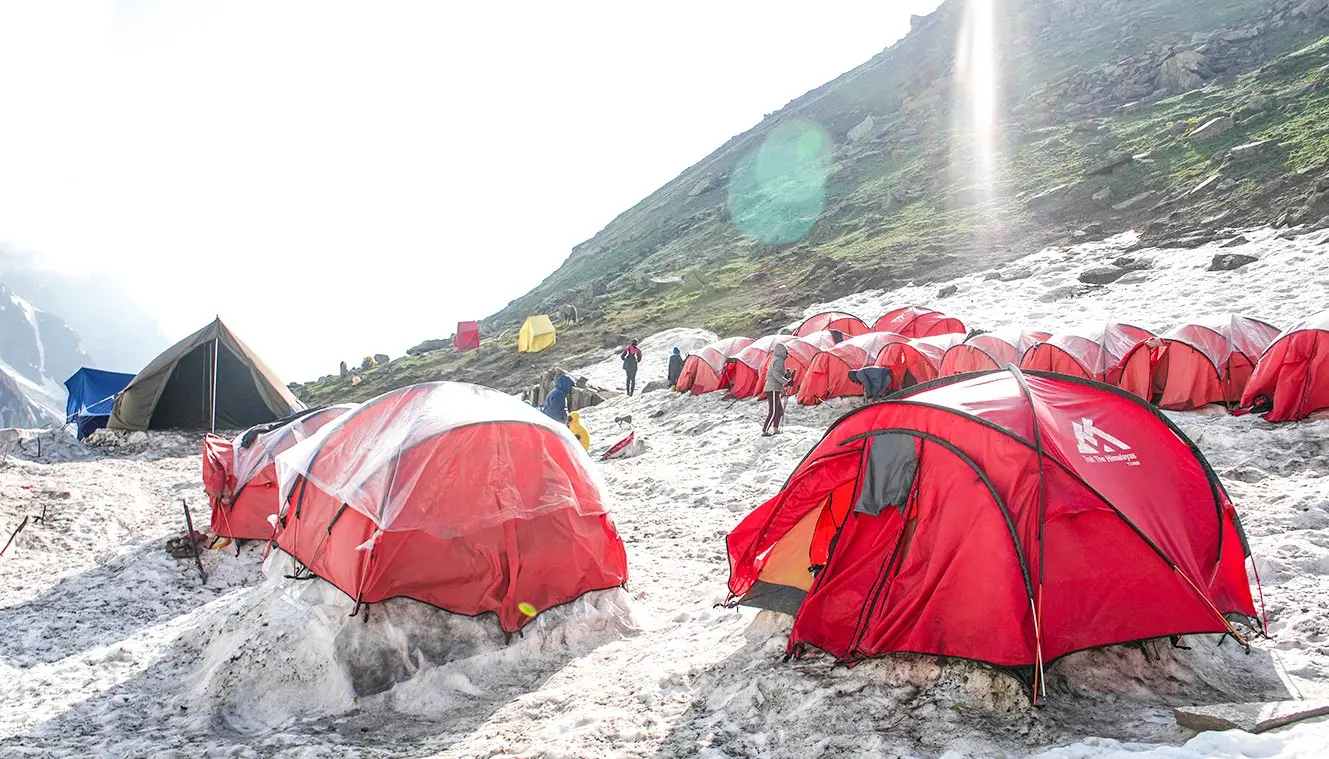
Once you reach the top, enjoy the enthralling views and while descending, it can be pretty risky to climb down without using ropes. It’s a very narrow ledge with steep drops on both sides. Follow your trek leaders’ instructions while descending.
Sliding down the ice walls, makes the descent very quick. In about 2 hrs, you will get out of the snow line, losing as much as 3000 ft. out of the snow line, you will now descend through forest covers of junipers with the views of a lush valley in front of you. Descend another hour and you will reach a stream that you need to cross and across the stream is our Riverside campsite where we will retreat for the night.
Munirang to Barua village & Drive to Shimla
- Altitude:- 2,300m/7,700ft.
- Altitude Loss:- 1,100m/ 3,400ft.
- Trek Distance: 5 km to 6 km | 2 -3 hr.
- Grade: Easy with gradual descent. Well-marked trail, crossing through mix forest.
- Carry 2 litres of water from campsite, only 3 water sources on the way.
- Reach Barua Village by 12:00 Pm.
- Lunch at Barua Village(not included in the cost).
- Leave for Shimla by 1:00 PM, Reach Shimla between 10:00 PM to 11:00 PM.
- Make your hotel bookings at Shimla accordingly.
Today we will begin our descent towards Barua village, the last leg of our journey. Along the path, you will see many different vegetation and diverse natural scenery. From Munirang, take the path that follows towards the Barua Khud. the trail is quite broad and well-defined here.
We will descend quickly through pine covers and other coniferous trees. About an hour and a half of descending, you will reach a gushing stream that meets the Barua Khud with a makeshift bridge across the stream.
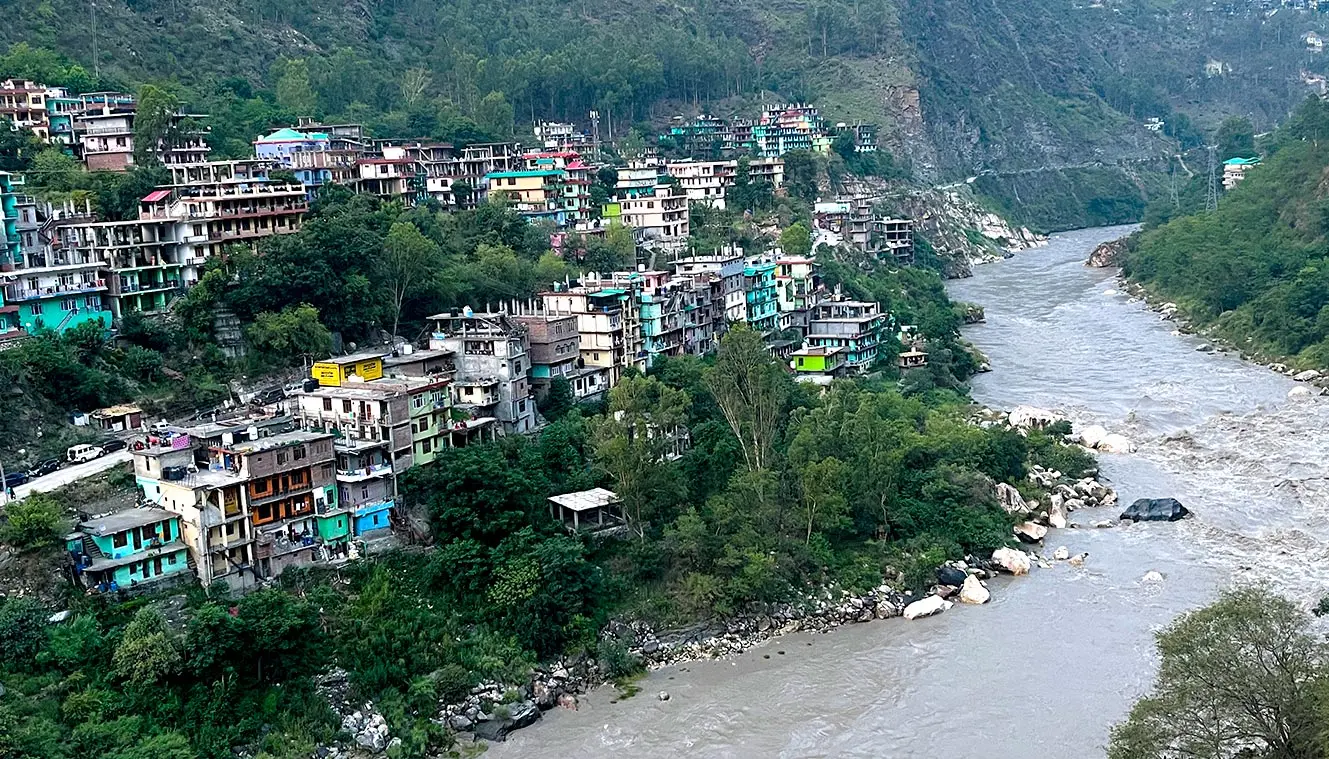
Once you climb across the bridge, you will come across another forest cover and about an hour into walking, you will see your first apple orchards and some signs of civilization. The trail soon enters the Barua Village following a long descent into the village. From the heart of the village, the descent is even more rapid, with a meandering route. In another half an hour, the road will open to Barua Khud Road. The pickup here is scheduled at 1:00 PM and you will reach Shimla by 10:00 - 11:00 PM. You are recommended to make your hotel bookings accordingly.
Note:
- Keep a buffer day in your travel plan
- If buffer day is not used in the travel then it can be used to Explore Shimla.
- Distance, Altitude, and Trekking hours are approximate and rounded off
- Keep the original and copy of ID proof handy
- Come one day early if planning to come by plane
Day-1: Shimla to Janglik
- Altitude:- 2,800m/9,200ft.
- Drive Distance: 160 km |9-11 hr.
Day-2: Janglik to Dayara Thatch
- Altitude:- 3,400m/11,150ft.
- Trek Distance: 4 km | 5-6 hr.
Day-3: Dayara Thatch to Litham
- Altitude:- 3,600m/11,800ft.
- Trek Distance: 5 km to 6 km.
Day-4: Acclimatization day, visit to Chandranahan Lake
- Altitude:- 4,023 m/13,200ft.
- Trek Distance: 4 km each side | 6-7 hr.
Day-5: Litham to Dhunda
- Altitude:- 4,000m/13,100ft.
- Trek Distance: 4 km to 5 km | 3-4 hr.
Day-6: Dhunda to Munirang (River camp) via Buran Ghati Pass
- Munirang Campsite Altitude:- 3,400m/11,100ft.
- Buran Ghatti Pass:- 4,550m/15,000ft.
- Trek Distance: 8 km (10 - 11 hrs approx).
Day-7: Munirang to Barua village & Drive to Shimla
- Altitude:- 2,300m/7,700ft.
- Trek Distance: 5 km to 6 km | 2 -3 hr.
Note:
- Keep a buffer day in your travel plan
- If buffer day is not used in the travel then it can be used to Explore Shimla.
- Distance, Altitude, and Trekking hours are approximate and rounded off
- Keep the original and copy of ID proof handy
- Come one day early if planning to come by plane

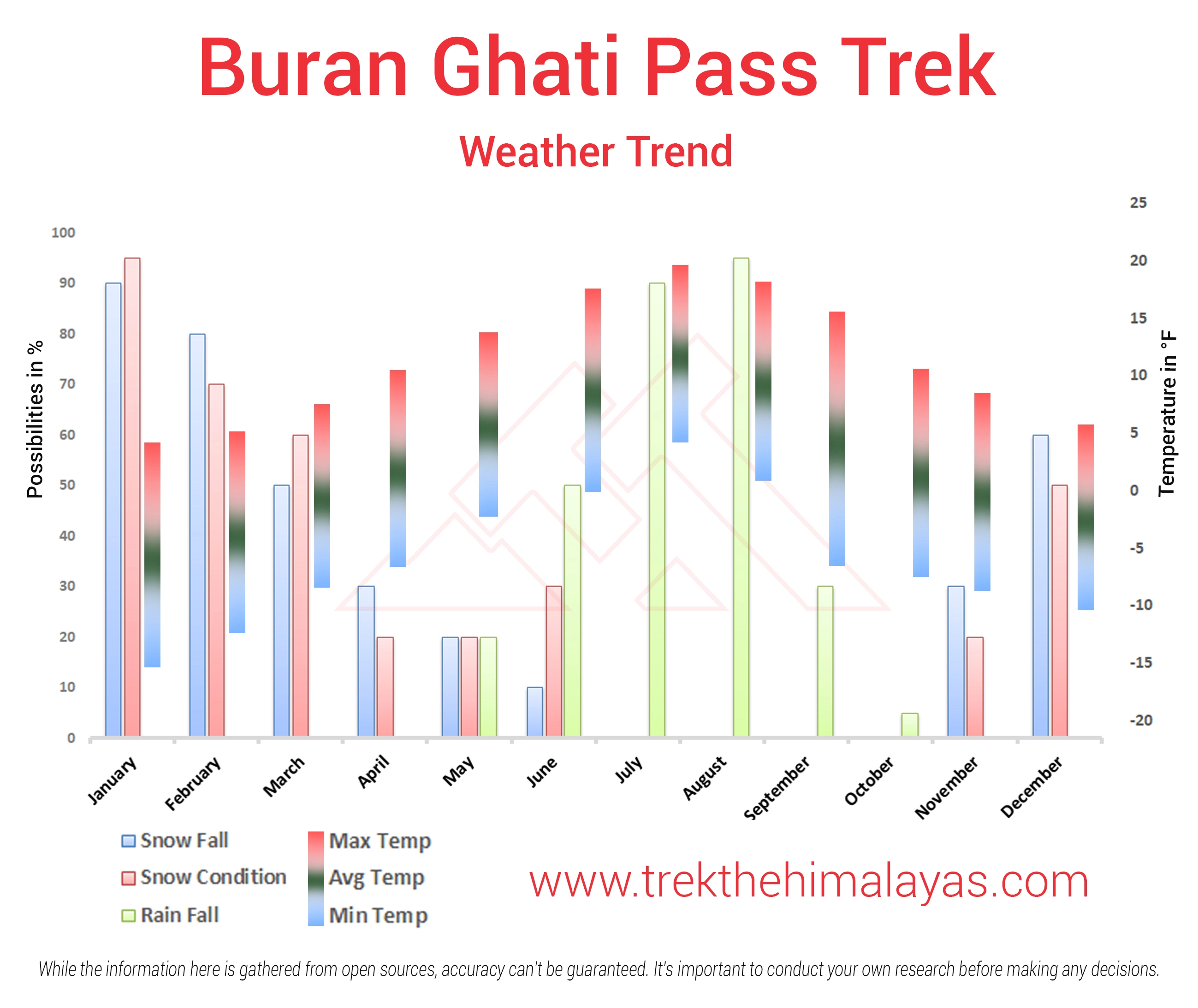
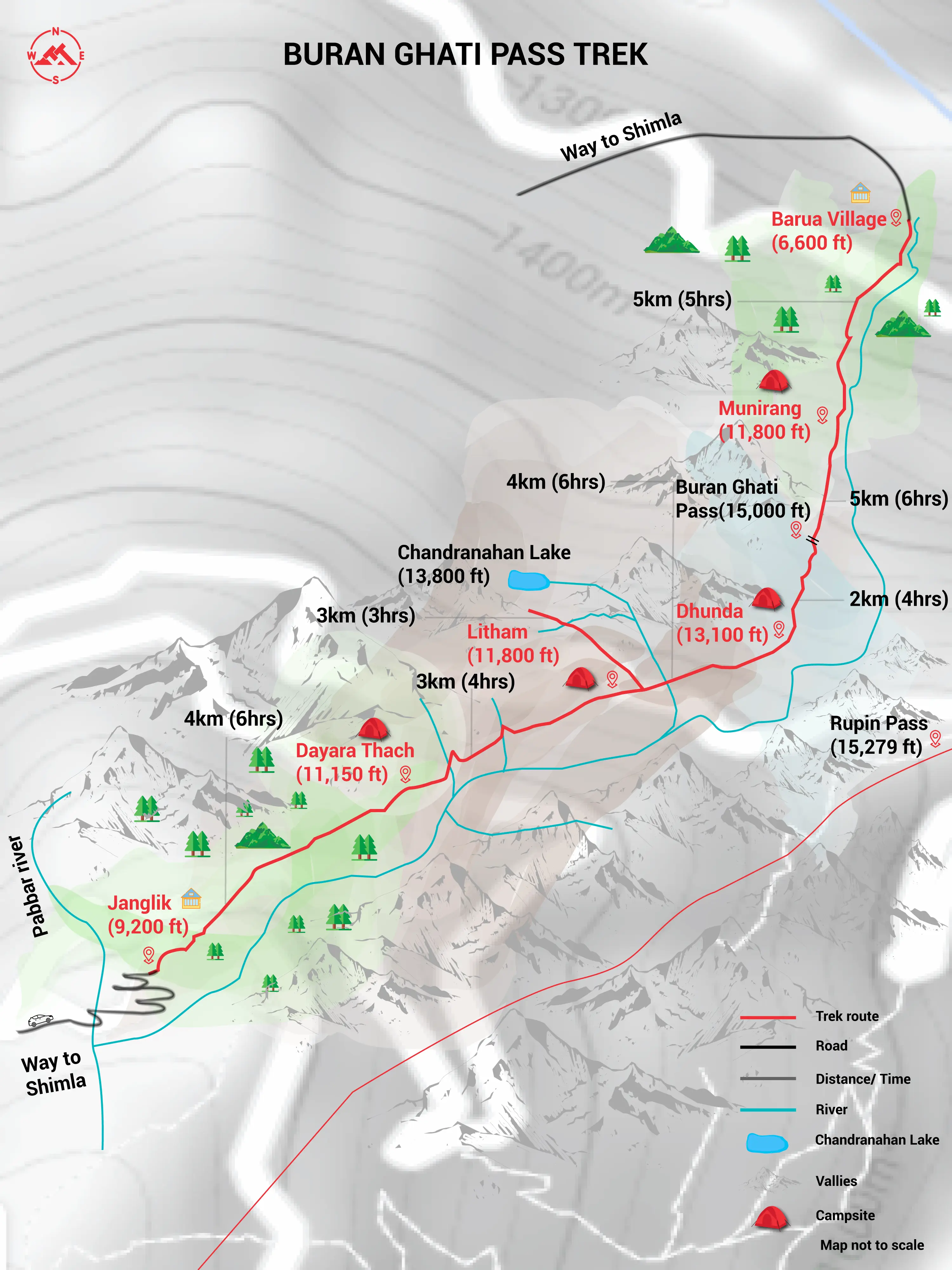
-
Pulse rate at rest must be in between (60 to 90 beats per minute).
-
Blood Pressure Reading must be in between (DIASTOLIC 70 – 90, SYSTOLIC 100 - 140 mm Hg).
-
Respiratory rate at rest must be in between (12 to 20 breaths per minute).
-
Should not have Liver and kidney issues.
-
Should not have Diabetes Mellitus, Bronchial Asthma, Heart problems, Hypertension, etc.
-
No pacemaker implant.
-
People with Sinus issues, Epilepsy please contact to trek coordinator before booking the trek.
-
If your BMI is not normal, Please contact our Trek coordinator before Trek booking.
Medical & Disclaimer Form (Mandatory Documents) Click here to download Medical & Disclaimer Form
- Government Employees can avail the benefit of Special Casual Leave (SCL) when they join us for a trekking expedition. As per the rules of the Pay Commission, Special Casual Leave can be availed for up to 30 days in a calendar year for trekking/mountaineering expeditions through a registered organization. Trek The Himalayas is a registered adventure tour operator by the Indian Mountaineering Foundation (IMF) and the Ministry Of Tourism (MOT).
- Trekkers have to apply for leave at least 20 days before the trek departure date.
- This service is exclusive to Indian government employees and is applicable only for treks within India.
- Do mail at info@trekthehimalayas to apply and mention your booked trek date and trek name.
- Junior trekkers (below 15 years) should have a company of parents/guardians.
- Trekkers between 15 to 18 years can come solo with the disclaimer form signed by parent/guardian.
- Medical & Disclaimer Form (Mandatory Documents) Click here to download Medical & Disclaimer Form
Important Links
Medical & Disclaimer Form (Mandatory Documents) Click Here.
How To Reach
It is essential for everyone to arrive at Shimla (06:00 am)
Meeting Place : Shimla old bus stand, Time : 6:00 AM
Once you have reached Shimla, TTH will manage the rest of your travel arrangements, if you have opted for TTH's pick-up service, you can select this option during the booking process by adding it as an add-on (book it at least 10 days before trek date)
It is advisable to reach Shimla a day before to avoid any kind of delays.
Options to reach Shimla
1 Take an overnight bus to Shimla, and then take a cab to the pickup point.
We always recommend going for the govt. Buses over the private ones outside the bus station as based on the experience we have found that there are very high chances of delay involved with private buses. Also, govt. Buses are always more reliable. Whichever bus you choose, just make sure to reach Shimla at least by 05:30 am.
2 Take a Train to Kalka and drive to Shimla. One can take the pleasure of a toy train, If you're arriving by Train, then come one day in advance.
3 Take a flight to Shimla airport (Jubbarhatti airport) (22 km, 50 min). If you're arriving by air, then come one day in advance.
If you prefer to travel independently, you can either take a government bus or book a private cab. Your trek coordinator will provide guidance on how to arrange for the bus or cab booking.
Arrive in Shimla by 11:00 pm.
The designated drop-off point is Shmila old bus stand.
Please arrange your hotel and make further bookings in Shimla accordingly.
TTH offers comfortable transportation through Tempo Traveler, Bolero, or equivalent vehicles. If you wish to upgrade your mode of transportation, please contact your trek coordinator for further assistance.
.webp)
Cost Terms
Inclusion
1. Accommodation (as per the itinerary):
- Homestay on Day 1.
- Camping during the trek (Day 2 to Day 6).
2. Meals (Veg + Egg):
- All meals are from Janglik to Barua village .
- Day 1 Dinner to Day 7 Packed lunch.
3. Support:
- 1 Versatile base camp manager: handles communication and deploys extra manpower in emergencies.
- 1 Mountaineering & First aid qualified professional expedition Leader.
- 1 Experienced high altitude chef.
- Local experienced guides (Number of guides depending on the group size).
- Enough support staff.
4. Trek equipment:
- Sleeping bag, Sleeping liners (if required), Mattress, Utensils.
- 3 men all season trekker tent (twin sharing), Kitchen & Dining tent, Toilet tent.
- Camping stool, Walkie talkie.
- Ropes, Helmet, Ice axe, Harness, Gaiters & Crampon (if required).
5. First aid:
- Medical kit, Stretcher, Oxygen cylinder, Blood pressure monitor, Oximeter, Stethoscope.
6. Transportation (as per the itinerary):
- Shimla to Janglik & Barua village to Shimla (If booked through TTH, available upon booking in add-ons).
7. Clock room service at Shimla.
8. Mules/porters to carry the central luggage.
9. All necessary permits and entry fees, Upto the amount charged for Indian.
10. Services from Janglik to Barua village.
Exclusion
- Insurance (Mandatory).
2. Food during the transit.
3. Any kind of personal expenses.
4. Mule or porter to carry personal luggage.
5. Emergency evacuation, hospitalization charge or etc.
6. Anything not specifically mentioned under the head Inclusion.
7. Transportation (Shimla to Janglik & Barua village to Shimla, if not booked through TTH).
Things can be provided on demand and availability (participant has to pay extra for these things).
1- Satellite phone/set phone - is a type of mobile phone that connects via radio links via satellites orbiting the Earth instead of terrestrial cell sites like cellphones. Therefore, they can operate in most geographic locations on the Earth's surface.
2- Gamow/PAC HAPO Bag (Portable Hyperbaric Bag) - is a unique, portable hyperbaric chamber for the treatment of acute mountain sickness (AMS), also known as altitude sickness.
3- AEDs (Automated External Defibrillators) - are portable life-saving devices designed to treat people experiencing sudden cardiac arrest, a medical condition in which the heart stops beating suddenly and unexpectedly.
Cancellation terms:
Cancellations prior to 25 days from the start of the Trip
Refund options
- 5% deduction of trek fee
- 100% cash voucher for any trip till one year
- Transfer your trek (any trek, any date) to your friend
Cancellation between 24 days and 15 days to the start of the Trip
Refund options
- 30% deduction of trek fee
- 100% cash voucher for same trip till one year
- 85% cash voucher for any trip till one year
- Transfer your trek (same trek, any date) to your friend
Cancellation between 14 days and 10 days to the start of the Trip
Refund options
- 50% deduction of trek fee
- 80% cash voucher for same trip till one year
- 70% cash voucher for any trip till one year
- Book the same trek, in the same season, with any other batch
- Transfer your trek (same trek, any date) to your friend
Cancellation less than 9 days to the start of the trek
Refund options
- No cash refund
- 20% cash voucher for the same trip till one year
- 10% cash voucher for any trip till one year
- Transfer your trek (same trek, same date) to your friend
Note- If a booking is made using a voucher or discount code, the policies related to vouchers and discounts cannot be modified.
In the unlikely event that TTH cancels a trek prior to the scheduled departure date:
While it is extremely rare for TTH to cancel a trek, we understand that unforeseen circumstances or natural disasters may occasionally require us to do so before the scheduled departure. These circumstances could include continuous rain or snow, thunderstorms, snowstorms, landslides, floods, earthquakes, or any other natural calamity that poses a risk to the safety of our trekkers. Additionally, unforeseeable events such as local riots, curfews, pandemics, lockdowns, government orders, or any similar situations that compromise the safety of the trekking experience may also necessitate a cancellation.
In the event of such a cancellation, TTH will provide you with a voucher equivalent to the amount you paid for the trek. This voucher can be redeemed for any of our treks within the next year, allowing you to still enjoy an adventure with us at a later date.
Note
-
The issuance of a voucher is not applicable in situations where you are required to descend from the trek for any reason. The trek leader may make the decision to send you down from the trek due to factors such as insufficient fitness level, symptoms of Acute Mountain Sickness (AMS), high blood pressure, exceeding the designated turn-around-time, health concerns, or if you are found smoking, drinking, or violating the rules set for the trek. In such cases, the provision of a voucher does not apply.
In the rare event that TTH shifts a trek:
We would like to emphasize that weather conditions in high-altitude areas are highly unpredictable and can undergo sudden changes at any time, irrespective of the day. Additionally, circumstances beyond our control, such as natural disasters, political unrest, pandemics, and lockdowns, may impact the feasibility of conducting a trek. In cases where we are unable to proceed with an event due to such circumstances that are beyond our direct control, we will make every effort to provide you with an alternative trek that is safer and more suitable.
In such situations, we will issue a voucher to offset the cost difference between the originally scheduled trek and the alternative trek. This voucher can be redeemed at any time within one year from the date of issue. Please note that a refund fee or reimbursement of the cost difference is not applicable in these cases.
Note:
- Change of trek batch is dependent on the availability of seats in the batch
- In case of transferring a trek to a friend, he/she should satisfy all the mandatory requirements put forward by TTH
- TTH holds the right to change/cancel the policies, without prior notice
- Cash refund is applicable only in case of bookings made without using any promotional offer code or vouchers
Cash Voucher Terms:
- This is a non-transferable voucher
- The voucher cannot be merged with any other offer of Trek The Himalayas
- The voucher is valid for Trek booked directly with Trek The Himalayas in India
- To avail the voucher please use your register phone number or e-mail id
- All the other Terms of booking a trek with Trek The Himalayas are applicable to the voucher
- Trek The Himalayas holds rights to add/remove any of the Terms and Conditions without prior notice
Itineraries are based on information available at the time of planning and are subject to change. "Trek The Himalayas" reserves the right to change expedition dates, people or itineraries as conditions warrant. If a trip must be delayed or the itinerary changed due to bad weather, road conditions, transportation delays, government intervention, airline schedules, sickness, or other contingency for which TTH or its agents cannot make provision, the cost of delays and/or other changes are the responsibility of the participant. TTH reserves the right to decline, or accept, any individual as a trip member for any reason whatsoever.
Trek Essentials
PDF Of Trek Essential Download
| Backpack with rain cover | (50 - 60 ltr) with comfortable shoulder straps |
| Day pack with rain cover | 20 - 30 ltr (If off-load opted) |
| Walking stick | Advisable (At least one) |
| Water Bottle / Hydration pack | 2 bottles of one liter each, People who use hydration pack 1 hydration pack and 1 bottle of one liter, Carry at least one thermos flask. |
| Small size tiffin/lunch box | 1 Nos |
| Snacks | Energy bars, dry fruits, electoral/ors |
| Personal Medical Kit | Consult your doctor |
| T-Shirt (Synthetic quick dry) | 1 Full & 2 Half sleeves |
| Fleece T-shirt | 1 Nos |
| Wind stopper / Fleece jacket | 1 Nos |
| Windproof Jacket | 1 Nos |
| Down feather / Hollow jacket | 1 Nos |
| Thermal inner (Upper and Lower) | 1 Pair |
| Trek Pant (Synthetic quick dry) | 2 Nos |
| Wind stopper / Fleece Pant | 1 Nos |
| Waterproof gloves | 1 Pair |
| Fleece / woollen gloves | 1 Pair |
| Poncho / waterproof Jacket and pant | 1 Nos |
| Sunscreen | 1 Nos |
| Moisturiser | 1 Nos |
| Chap-stick / Lip balm | 1 Nos |
| Toothbrush and toothpaste | 1 Nos |
| Toilet paper & Wipes | 1 Nos |
| Soap / hand sanitizers | 1 Nos |
| Antibacterial powder | 1 Nos |
| Quick dry towel | 1 Nos |
| Head torch | 1 Nos. (Avoid Hand torch) |
| Sun Cap | 1 Nos |
| Woolen cap | 1 Nos. |
| Balaclava | 1 Nos. |
| Buff / Neck-gaiters | 1 Synthetic & 1 Woollen |
| Sunglasses | UV with dark side cover, People who wear spectacles - (A)- Use contact lenses | (B)- Photo chromatic glasses |
| Trekking shoes | 1 Pair (Waterproof, high ankle, good grip) |
| Floaters / flip-flops | 1 Pair |
| Cotton socks | 6 pairs |
| Woollen socks | 1 pairs |
| Gaiters | 1 Pair (TTH provides when required) |
| Micro spikes | 1 Pair (TTH provides when required) |

Frequently Asked Questions(FAQ)
To register with TTH, visit our website - www.trekthehimalayas.com and create your account. To create your account you will need to use your email address and fill in all the details, set your unique password and your account is ready to use.
- To book a trek with TTH, you first need to register with us and create an account.
- Choose the trek that you want to do and click on available dates.
- You will land at the login page, fill in the required details.
- Add Participants, choose add-on services click on the Pay now button, choose your preferred payment method, and make the payment. TTH accepts multiple payment options, including credit/debit cards, net banking, and UPI.
- You will receive a confirmation email from TTH with all the necessary details about the trek, including the meeting point, transportation, accommodation, and other important instructions.
please send an email to us at info@trekthehimalayas.com or reach out to the numbers provided in the Help and Support section of your Trek Page. We will ensure that your issue is promptly resolved.
To book services such as off-load luggage and transportation, you can find them listed as add-ons. These additional services can be booked at the time of your initial booking. If you miss booking add-ons during the initial reservation, you can log in anytime and easily book 4 days before the departure date add-ons through the platform.
In such a situation, please log in to your account and transfer your trek or date to the desired one within 12 hours or drop us an email at info@trekthehimalayas.com 10 days before the departure date of the trek. After the initial 12-hour period, any changes will be processed according to the cancellation policy.
We recommend visiting our "Suggest Me a Trek" page. By filling out the form, our experts will contact you with the best possible trek options based on your preferences and experience level. Alternatively, you can reach out to us via email at info@trekthehimalayas.com or give us a call using the numbers provided on our website for personalized assistance and recommendations.
Family treks differ from regular treks by focusing on ease of difficulty, offering shorter durations for younger participants, Kid-friendly and easily digestible foods, child-friendly activities, maintaining a higher guide ratio for diverse age groups, and implementing additional safety measures for families.
Family Trek with Kids recommendation Only Dayara Bugyal and Chopta Chandrashila Trek.
Minimum age for TTH treks is typically 7 years, though this may vary depending on the specific trek.
Yes, you can take a kids to a high-altitude trek with a parent. Discuss with a trek expert before booking a trek.
Junior trekkers (below 15 years) should have a company of parents/guardians.
Trekkers between 15 to 18 years can come solo with the disclaimer form signed by parent/guardian.
Medical & Disclaimer Form (Mandatory Documents) Click here to download medical and disclaimer form
Physical Fitness: Ensure your child is physically fit. Engage them in regular exercise, outdoor activities, and hikes to build stamina and endurance. Hydration: Emphasize the importance of staying hydrated at high altitudes. Encourage your child to drink water regularly, even if they don't feel thirsty. Proper Nutrition: Provide a well-balanced diet with sufficient carbohydrates for energy and foods rich in iron to prevent altitude sickness. Adequate Sleep: Ensure your child gets enough sleep in the days leading up to the trek. Quality rest is crucial for altitude adaptation. Educate on Altitude Sickness: Teach your child about the symptoms of altitude sickness, such as headache, nausea, and dizziness. Encourage them to communicate any discomfort immediately. Appropriate Clothing and Gear: Dress your child in layers to adjust to changing temperatures. Ensure they have appropriate trekking gear, including sturdy footwear. Positive Mindset: Foster a positive mindset. Encourage your child, and let them know it's okay to take breaks when needed. Medical Check-Up: Schedule a medical check-up before the trek to ensure your child is fit for high-altitude activities. Consult with a healthcare professional about any potential health concerns.
TTH takes special care to provide wholesome and nutritious food for children on treks. Here are some of the foods that are typically served for children:
Breakfast: For breakfast, TTH serves a variety of options like porridge, cornflakes, bread, butter, jam, honey, boiled eggs, omelettes, and pancakes. Children can choose from these options to fuel themselves for the day's trek.
Lunch: For lunch, TTH serves lunch which includes rotis, vegetables, rice, dal, and salad. The rotis are usually made fresh on the trek and are a good source of carbohydrates. The dal and vegetables provide protein and other essential nutrients.
Snacks: TTH provides healthy snacks like fresh fruits, dry fruits, energy bars, cookies, and biscuits to keep the children energized throughout the day.
Dinner: For dinner, TTH serves a hot and wholesome meal which includes soup, rice, dal, vegetables, and a non-vegetarian dish (if requested in advance). Children can also choose from a variety of desserts like custard, jelly, and fruit salad.
Dietary requirements: If a child has any special dietary requirements, TTH can cater to those needs as well. For example, if a child is lactose intolerant or allergic to nuts, the kitchen staff can make arrangements to accommodate those requirements.
Choosing the right trek for a beginner can be a bit overwhelming as there are many factors to consider such as distance, elevation gain, terrain difficulty, weather, and time of year. Here are some tips that can help you choose the right trek for a beginner:
1. Determine fitness level: Assess the fitness level of the beginner to understand their physical capabilities. This will help you select a trek that is challenging but not too difficult.
2. Choose a well-traveled trail: A well-traveled trail will have more amenities such as signposts, water stations, and shelter. It is also safer as there will be other hikers on the trail.
3. Consider the length of the trek: For beginners, it is recommended to start with a shorter trek that can be completed in a day or two. This will help them get acclimatized to trekking and build their confidence.
4. Look for gradual elevation gain: Choose a trek with a gradual elevation gain rather than steep ascents. This will make the trek easier and more enjoyable.
5. Check the weather: Check the weather forecast before selecting a trek. Avoid treks during the monsoon season or winter when the trails can be slippery or dangerous.
6. Research the trail: Read about the trail to get an idea of the terrain, altitude, and difficulty level. This will help you select a trek that is suitable for the beginner.
7. Consult with an expert: If you are unsure about which trek to choose, consult our trek expert Mr. Nitin (+91 70600 59773) between 10 AM to 6 PM (Tuesday - Friday). Mr. Nitin will provide you valuable advice and guidance.
Overall, it is important to choose a trek that is enjoyable, challenging but not too difficult, and suitable for the beginner's fitness level and experience.
It is not recommended for a beginner to choose a difficult Himalayan trek. Trekking in the Himalayas can be physically and mentally challenging, especially if you are not used to the high altitude, steep slopes, and rugged terrain. Choosing a difficult trek without the proper experience, fitness level, and preparation can be dangerous and put you at risk of altitude sickness, injury, and other hazards.
If you are a beginner, it is recommended to start with an easier trek and gradually build up your skills and experience. This will help you understand the challenges of trekking in the Himalayas, and also prepare you physically and mentally for a more difficult trek in the future. It is also important to choose a trek that matches your fitness level, experience, and interest.
There is no specific age limit for a beginner trekker. However, it is important to consider your physical fitness, health condition, and personal interests before embarking on a trek. Trekking in the Himalayas can be physically and mentally demanding, and requires a certain level of physical fitness and endurance.
If you have any pre-existing medical conditions or are above a certain age, it is recommended to consult with a doctor before embarking on a trek. It is also important to listen to your body and take breaks as needed during the trek to prevent exhaustion or injury.
We recommend visiting our "Suggest Me a Trek" page. By filling out the form, our experts will contact you with the best possible trek options based on your preferences and experience level. Alternatively, you can reach out to us via email at info@trekthehimalayas.com or give us a call using the numbers provided on our website for personalized assistance and recommendations.
Yes, you can join the trek. We have fixed departure groups where you can simply book your trek and we will take care of curating a group.
Before you start the trek, it is recommended that you make all the necessary phone calls as during the trek you may or may not receive network coverage, once you come back to the Base Camp, you can reconnect with your family via phone once again. You can share your trek coordinator contact detail with your family members to get the latest updates about your trek batch.
At TTH, we provide wholesome and nutritious meals during the trek. The food is vegetarian and includes a variety of dishes such as rice, dal, vegetables, chapati, paratha, pasta, noodles, and soup. We also offer snacks such as biscuits, and salty, and dry fruits during the trek. Special dietary requirements such as vegan, gluten-free, or Jain food can also be arranged if informed in advance.
If you are allergic to some foods, you need to let us know in advance so that we can make arrangements accordingly.
TTH is a trekking company that prioritizes the safety of all its participants, including women trekkers. They have a comprehensive safety system in place, which includes a dedicated team of experienced and trained trek leaders and support staff who are equipped to handle emergency situations and provide first aid.
TTH also takes specific measures to ensure the safety and comfort of women trekkers. They have a separate tent accommodation for women trekkers, female trek leaders, and support staff. They also provide separate toilet facilities for women and encourage a safe and respectful environment for all trekkers.
Moreover, TTH has a strict policy against any kind of harassment and has a zero-tolerance policy towards such incidents. They have a designated Internal Complaints Committee (ICC) to investigate and address any complaints related to harassment or misconduct. Overall, TTH has a good reputation for safety and responsible trekking practices, and women can feel comfortable and safe while trekking with them.
In case you are the only women in the group, we provide a single sleeping arrangement. Also, during the trek, the trek leader will always remain by your side to provide optimum safety and reassurance.
You can reach out to the trek coordinator to inquire about the number of female trekkers and their respective states who have booked the trek. Please note that the trek coordinator cannot disclose personal details of any trekker. Once you've confirmed your booking, a WhatsApp Group will be created for all the trekkers in your batch. This allows you to connect with fellow trekkers before the trek begins.
While many of our treks are led by female trek leaders, however, it is not possible to know which trek leader is assigned to which group. But nonetheless, whether the trek leader is male or female you can be completely assured of your safety and security with us.
Yes, it is possible to trek with periods. However, it is important to take some extra precautions and preparations to ensure a comfortable and safe trekking experience.
Here are some tips that can help you trek during your period:
1. Use menstrual hygiene products that you are comfortable with, such as tampons, pads, or menstrual cups. It is recommended to carry enough supplies for the entire duration of the trek.
2. Pack wet wipes, hand sanitizer, and plastic bags to dispose of used hygiene products.
3. Wear comfortable and breathable clothing that allows for easy movement and reduces friction. Avoid wearing tight or restrictive clothing that can cause discomfort.
4. Carry pain relief medication, such as ibuprofen or acetaminophen, in case of menstrual cramps.
5. Stay hydrated and maintain a balanced diet to support your energy levels and overall health.
6. Take breaks as needed and listen to your body. If you feel uncomfortable or experience any unusual symptoms, seek medical attention immediately.
It is also recommended to consult with a doctor before going on a trek during your period, especially if you have a pre-existing medical condition or are taking medication. By taking necessary precautions and being prepared, you can have a safe and comfortable trekking experience even during your period.
We provide proper disposal facilities for sanitary pad disposal during the trek.
We offer three person tents with twin-sharing for optimum comfort. A woman trekker will share a tent with another woman trekker and if you are the only woman in the group, you will be given a single accommodation for your comfort and privacy.
Yes, we do provide gears on rent. You can book it using you TTH account directly.
Mountaineering qualified Experienced and first aid certified Trek Leader, First Aid Certify local guide, Cook, helpers and supporting staff.
People suffering from Bronchitis, Asthma, High blood pressure, Epilepsy (got faints), TB , Heart problem or on higher BMI side are strictly not allowed to go on any Himalayan trek. Apart from this if you had any medical history, please let us know.
No. Alcohol and smocking isn’t allowed while on trek. It is totally misconception that it will keep you warm. Your body need to acclimatize properly and for that eat properly and drink enough water; these things will keep you warm.
Toilet tents provide a convenient solution for answering nature's call in the great outdoors. Dry toilets, in particular, offer a highly sanitary approach. By digging a pit and utilizing mud and a shovel, you can easily cover up your waste. This method ensures cleanliness and hygiene while camping or exploring in the forest.
Remember to pack essential toiletries to complete your outdoor bathroom kit and maintain proper personal hygiene during your adventures. With these practices in place, you can enjoy nature while also respecting it.
Layer Up From Head To Toe
Eat Full Meals, never sleep empty stomach
You can keep warmee (if you’re more susceptible to cold).
Use sleeping bag in right way and don’t leave free space in sleeping bag.
For upper body
– Thermal layer
– T-shirt (full-sleeves)
– Fleece T-shirt (for extreme colds)
– Fleece layer
– Thick Jacket/Down Jacket
– Waterproof or Windproof layer (outermost layer, when it is snowing or raining)
- For Lower Body
– Thermal layer
– Hiking pants (normal) or Winter hiking pants
Based on how warm you feel you can skip any of the above layers. Your outer later should be windproof since it is windy at high altitude.
The idea behind layering is that the more insulation you have the less cold you feel, and instead of wearing a very thick jacket if you wear multiple layers, your body will be better insulated against the cold.
Yes, we provide micro spikes and gaiters, if required.
Mandatory documents: 2 xerox of ID having address (addhar card/driving license), 2 Passport size photographs, hard copy Medical form signed & sealed by doctor, disclaimer form sign by trekker and high altitude insurance.
No. We don’t but we can suggest you good hotel/Stay nearby pick up location.
Yes, trekker must carry 2 water bottles 1 litre each so they can refill it at campsite for drinking and keep themselves hydrate.
You should buy shoes which has these three features –Good grip, Ankle Support and additional water resistant layers. Generally, we advise Quechua Trek 100, MH 500 and MH 100.
No one is forced to go on. There is always enough staff to split the party according to need and regroup later at the camp. Most people have no trouble reaching the highest campsite. If some members decide not to climb the final distance they can wait for the climbers to come back down the same way or take a lateral path to the descent route.
Buran Ghati Trek is approximately 26 km long.
The starting point of Buran Ghati Trek is the Himalayan hamlet of Janglik.
The altitude of the Buran Ghati Trek is 15,000 ft.
Buran Ghati Trek is a moderate-difficult grade trek.
The best time to do the Buran Ghati Trek is during the summer months of May to June and the post-monsoon months of September to October. During these months, the weather is generally clear, with warm days and cool nights, making it ideal for trekking.
We stay in Home stay (dormitory with ground mattress on Day 1, it is separate for male and female) and for remaining days camping (twin sharing basis).
Buran Ghati trek is a 7-day long trek.
All meals are included starting from day 1 dinner till day 7 breakfast. At TTH, we provide wholesome and nutritious meals during the trek. The food is vegetarian and include a variety of dishes such as rice, dal, vegetables, chapati, paratha, pasta, noodles, and soup. We also offer snacks such as biscuits, namkeen, and dry fruits during the trek. Special dietary requirements such as vegan, gluten-free, or Jain food can also be arranged if informed in advance.
Yes, prior trekking experience is necessary for Buran Ghati Trek.
Buran Ghati Trek is a moderate to difficult level trek and as such you need a good deal of physical fitness for the trek.
Yes, we will provide sleeping, tent, mattress. It is among the central equipment.
Pickup/ Drop Point: Shimla Old Bus Stand
Reporting Time: 6:00 AM on trek date // Drop Time: 10 PM to 11 PM.
Note: It is advisable to come one day in advance.
We always share driver details and vehicle number 1 days prior the trek date, so you can call him on your arrival if you’re having problem with finding vehicle.
We use Force Cruiser (shared by 8 people) to travel from Shimla to Janglik and Sumo/Bolero or equivalent (shared by 6 people) from Barua to Shimla. We arrange vehicle depending on availability and final batch size.
Yes, Offloading facility is available. You should book it in advance and pay us Rs.2200/- per bag for all trekking days or book it after reaching there, and for that you need to pay Rs.2500/- per bag for all trekking days. Bag weight should not more than 10 kgs.
Last network point is Rohru (en route to Janglik) after that no network.No network while trekking.
There isn’t any charging point on trek. Janglik is the only place where you can charge your mobile phone and camera after that you need to rely on your power bank or batteries.
You should buy shoes which has these three features –Good grip, Ankle Support and water proof. Generally, we advise Quechua Trek 100, MH 500 and MH 100.
Yes, it is necessary. It is additional support which helps you reduce tiredness and give you strength and balance.
